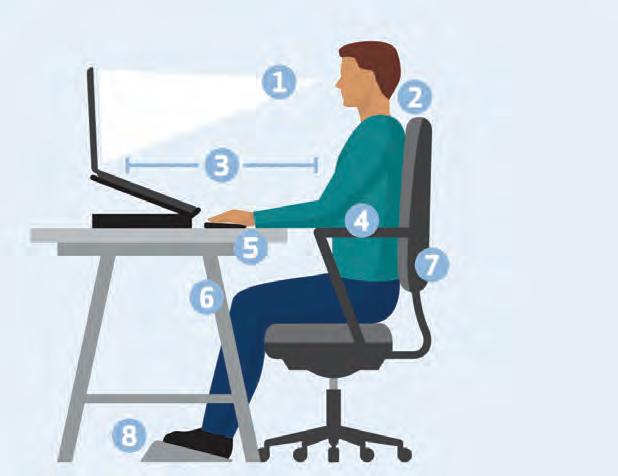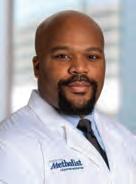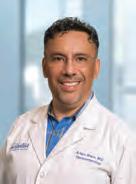LEADING MEDICINE
KNOW YOUR NUMBERS: How Your Doctor Can Help You Stay in a Healthy Range

Diagnosing Common Gastrointestinal Conditions
Ergonomics at Work: 3 Tips to Avoid Back & Neck Pain
WINTER 2023 YOUR
NEWS
IN
LINK TO HEALTH INNOVATIONS,
AND TIPS
NORTHWEST HOUSTON
3 Tips to Get Healthy After the Holidays
Weight loss expert offers tips to help you get healthy and lose weight in the new year.
4
Health Numbers You Should Know
Learn more about the health indicators you should talk about with your doctor.
6 Understanding Your Digestive Health
Find out about common GI conditions and symptoms you shouldn’t ignore.
7
Ergonomics on the Clock: Tips to Avoid Back and Neck Pain While Working

An expert provides tips for setting up your workspace to keep you pain free.
E mergency Care Clinic Opening Soon in Magnolia
As part of our mission to bring leading medicine to the Northwest Houston community, Houston Methodist is opening a new emergency care center (ECC) in Magnolia. The ECC, located off of FM 1488 between Highway 249 and FM 1774, is on the first floor of the Magnolia Landmark Building, where we currently operate a primary care clinic. This expansion into Magnolia will provide area residents with convenient access to hospital services with both Willowbrook to the south and The Woodlands to the east. The ECC will include traditional emergency services as well as outpatient imaging.
Houston Methodist Emergency Care Center in Magnolia
18230 FM 1488
Magnolia, TX 77354
Tomball Clinic Expanding Specialty Services in Summer

The Houston Methodist clinic in Tomball, located at the intersection of Highway 249 and FM 2920, is expanding to offer more specialty services at a convenient location for Northwest Houston residents. We are doubling the size of the clinic to add specialists to the existing primary care physicians. The clinic will offer neurology, cardiology, primary care sports medicine, and rotating orthopedic surgeons specializing in hand, sports, foot and ankle. Additionally, X-ray, mammograms, and bone density screenings will be available. These new services will begin summer 2023.

Houston Methodist Primary Care Group in Tomball
14211 FM 2920
Suite 110
Tomball, TX 77377
To schedule an appointment with a primary care physician, visit houstonmethodist.org/pcg/tomball or call 281.737.1910 .
2 LEADING MEDICINE FROM HOUSTON METHODIST
IN THIS ISSUE | WINTER 2023
NEWS & EVENTS
TIPS TO GET HEALTHY AFTER THE HOLIDAYS
The holidays are a time of reconnecting with loved ones and often include gathering around big meals filled with family recipes. As the season ends, many people embrace the new year as a fresh start. This often means improving your health through weight loss and exercise, but it’s not always easy.

“Based on human evolution, our biology and sacred pastimes, we have a tendency to congregate around food,” said Dr. Victoria Chang, a board-certified bariatric and laparoscopic surgeon at Houston Methodist Center for Weight Loss & Bariatric Surgery at Willowbrook. “While there’s nothing wrong with enjoying a special meal, that pattern can make losing weight very difficult.”
With that in mind, Chang offered tips for getting healthy in the new year.
BUILD A HEALTHY LIFESTYLE
Getting healthy is about more than losing weight. In fact, said Chang, losing weight should be a beneficial side effect of becoming healthier. “Fad diets don’t work,” she said. “Instead, focus on eating healthy foods and living an active life.” Here are some steps to get you started:
1. S et SMART goals. To help ensure you’re making progress, set SMART goals: specific, measurable, achievable, relevant and time bound. For example: briskly
walk on a treadmill for 45 minutes, five days per week, for the next 30 days.
2. O pt for healthy food choices. When it comes to nutrition, there’s a lot of bad information online. Follow these sensible eating tips:
■ Avoid processed foods and sugar.
■ Avoid snacking.
■ Eat more plant-based foods, like fruits, vegetables, beans and lentils.
■ Include more fiber in your diet.
3. B e aware of “mindless” habits. It’s common to snack when stressed or bored. Once you’ve identified the thoughts and patterns that drive you to reach for unhealthy foods, you can interrupt them before they occur. Chang suggested posting a list of “smart swaps” on the fridge to remind yourself to reach for an apple instead of potato chips, for instance.
4. E xercise five days per week. Experts recommend getting 60 minutes of exercise per day, five days a week. Include both resistance training and cardiovascular exercise in your routine. Walking, running, bicycling and swimming are great cardio exercises.
If your efforts to get healthy at home aren’t achieving the results you want, you may benefit from talking with an expert. “Our weight loss specialists can help with lifestyle changes and recommend methods like medications and surgeries that could aid you in achieving your health goals,” Chang offered. •
Get Started on Your Weight Loss Journey
To talk with a weight loss specialist, visit houstonmethodist.org/ weight-management or call 832.667.5673

BAKED PISTACHIO CRUSTED SALMON
Ingredients:
2 salmon filets, 6 oz each
1 clove of garlic, minced
1 tbsp olive oil
¼ tsp Dijon mustard
1 tbsp honey
¹⁄ ³ cup pistachios, coarsely chopped
Salt and pepper, to taste
Directions:
1. Preheat oven to 375° F
2. Rinse s almon and pat dry. Place salmon on a lined baking sheet. Season with salt and pepper to taste.
3. In a small bowl, combine garlic, olive oil, mustard and honey. Spread ¾ of the mixture evenly over the salmon.
4. Add pist achios to the remaining mixture and stir to combine. Spoon the pistachio mixture on top of the salmon and press lightly into salmon using the back of a spoon.
5. B ake for 15-20 minutes until salmon is flaky. Remove from oven and let rest for 5 minutes before serving.
CHECK OUT OUR DIGITAL MAGAZINE AT HOUSTONMETHODIST.ORG/NEWSROOM/NEWSLETTERS 3
Dr. Victoria Chang
HEALTH NUMBERS YOU SHOULD KNOW
How Your Doctor Helps You Stay Healthy

Your primary care provider, or PCP, is one of your most important health resources. But what does a PCP do?
“My job is to help you stay healthy,” explained Dr. Jeremy Fleeks, a board-certified primary care sports medicine physician at Houston Methodist Willowbrook. “I help my patients by identifying possible issues and monitoring ongoing health conditions. We work together on preventative measures to catch issues early and improve overall health.”

Your PCP performs annual check-ups and is usually the first stop if any illness or health concerns arise. But they also help you understand and reduce your risk for developing a wide variety of conditions. PCPs monitor your overall health and make recommendations for any necessary medications, lab work, immunizations, and referrals to specialty providers. Together, you and your PCP can help you continue to live the life you love.
To keep an eye on your health, your PCP examines several key
numbers to check your risk for developing serious diseases. For a helpful next visit, be prepared to talk with your doctor about these important indicators.
IMPORTANT NUMBERS TO KNOW
By understanding your numbers, you can reduce your risk of developing cardiovascular disease – the leading cause of death in both men and women in the U.S. – as well as other health conditions, such as stroke, diabetes and obesity.
■ Blood Pressure: A measurement of the amount of force your heart needs to pump blood throughout your body. Blood pressure is measured by two numbers: systolic (when your heart pumps blood out) and diastolic (when your heart rests between beats).
✓ Healthy target: less than 120/80 mmHg
Risks: High blood pressure can negatively affect the function of your heart and other major organs, such as the kidney and brain. It’s also the leading cause of stroke.
4 LEADING MEDICINE FROM HOUSTON METHODIST
Dr. Jeremy Fleeks
■ Body Mass Index (BMI): A measurement of your weight divided by your height, squared.
✓ Healthy target: 18.5 to 25 kg/m2
Risks: The higher your BMI, the greater your risk of heart disease, high blood pressure, type 2 diabetes and certain cancers.
■ Fasting Blood Sugar: A measurement of the amount of glucose in your blood after fasting for eight to 12 hours.
✓ Healthy target: below 100 mg/dL
Risks: Hyperglycemia, or high blood sugar, can damage the blood vessels and nerves in the eyes, heart, kidneys, and extremities over time. It can also lead to type 2 diabetes.
■ Total Cholesterol: A measurement of cholesterol (a fat-like substance made in the liver and found in foods) in your blood.
✓ Healthy target: less than 200 mg/dL. Talk to your doctor to understand all of your cholesterol (lipid) levels, including LDL, HDL and triglycerides, and what they mean for your heart health.
Risks: Excess cholesterol can build up in the walls of the arteries,
leading to narrowing or blockages in your vessels, which increases your risk of heart attack or stroke.
Some risk factors are genetic or out of your control, like family history, age and sex — but there’s still a lot you can do to keep your numbers in a healthy range.
HOW YOUR PCP CAN HELP
The best way to know your numbers and understand how they impact your health is to visit your PCP. As your health partner, they can perform or order tests to check these important measurements and help you make a personalized plan to get back within healthy range if necessary. Plans can include increasing your activity level, adopting healthy eating habits, quitting smoking, limiting alcohol and learning how to check and manage your blood pressure.
Building a partnership with your PCP and working with them to know and manage your numbers can dramatically reduce your risk of heart disease and other health complications. •
GET
TO
KNOW YOUR CARE TEAM
Chances are you may have seen a nurse practitioner (NP) or physician assistant (PA) during a doctor’s office visit sometime in your lifetime. While they are not medical doctors, these highly trained health care providers work hand in hand with physicians as part of your health care team.
These providers have the expertise to diagnose and treat patients in a variety of specialties. They undergo years of medical training — in fact, most have a master’s degree or a doctorate. Working under the supervision of your doctor, PAs and NPs perform clinical exams, diagnose and treat illnesses, order labs and tests, and prescribe medications. Houston Methodist is home to dozens of such providers, who provide expert, compassionate care throughout the system.
YOUR HEALTH by the numbers
For these key measurements, keeping your results within these healthy ranges will go a long way toward maintaining your best heart health.
Blood Pressure: Less than 120/80 mmHg
Body Mass Index: 18.5 to 25 kg/m2
Fasting Blood Sugar: 80 to 99 mg/dL
Total Cholesterol: Less than 200 mg/dL
Talk
HOUSTONMETHODIST.ORG 5 Visit houstonmethodist.org/cancer-wb to learn more. Houston Methodist provides primary care that’s personalized for you and your unique needs. To find a primary care provider near you or make an appointment, visit houstonmethodist.org/pcg/ northwest or call 713.441.7965.
Appointment
Make an
With a Primary Care Provider
can
to
back in a healthy range. If
have
or other health conditions, your goal numbers may vary.
with your primary care provider about these important tests and steps you
take
get
you
diabetes
Understanding Your Digestive Health
DIAGNOSING COMMON GASTROINTESTINAL CONDITIONS
If you have unexplained or frequent digestive issues, such as abdominal discomfort or changes to your bowel habits, your primary care physician may refer you to see a gastroenterologist, or GI doctor. But if you've never seen a GI before, you may be unsure whether your symptoms really warrant seeing a specialist.

WHAT IS A GASTROENTEROLOGIST?
A gastroenterologist is a specialist who is trained to diagnose and treat disorders that affect your gastrointestinal tract and liver. “The GI tract is essentially the passageway that food follows in your body and all the organs that make up the digestive system,” said Dr. Arturo Bravo, a gastroenterologist at Houston Methodist Willowbrook Hospital. “Because every individual and their GI issue is unique, it is important to see a specialist for a detailed assessment.”
The digestive disorders and issues that a gastroenterologist treats can be classified in two ways: functional or structural.
Functional GI disorders are the most common and are usually easily treatable. Common symptoms can include constipation, cramping, abdominal pain, nausea, gas, bloating, heartburn and diarrhea.
“ Treatments for functional disorders tend to be focused on lifestyle changes like eating healthy, exercising and stress management,” said Bravo.
Structural GI disorders are more serious in nature and are caused by abnormalities in the gastrointestinal tract. Common examples of structural GI disorders include colitis, strictures, stenosis, hemorrhoids, diverticular disease, colon polyps and colon cancer.
Based on your symptoms, your gastroenterologist can perform a procedure to help diagnose and treat these digestive conditions. This could include an upper endoscopy to visually examine the esophagus, stomach and small intestine, a colonoscopy to examine the large intestine, a biopsy, or other endoscopic techniques needed to visualize the digestive system.
GI specialists will work with you to understand your symptoms and determine the type of disorder you have, which will result in finding you the right treatment options.
AT YOUR GI APPOINTMENT
At your first appointment, your gastroenterologist will:
■ Ask you about your digestive symptoms and medical history.
■ Discuss any tests, screenings or procedures that may be needed.
■ Recommend any lifestyle changes or medications that can help relieve your symptoms.
“ To make the most of your appointment, come with a list of your symptoms so that you don't forget to ask about any of the issues you're having,” Bravo suggested.
Through this initial evaluation, your doctor will start the process of discovering the cause of your digestive issues and begin addressing your symptoms. If your condition is chronic, your specialist will discuss how best to manage your condition over time. They may also talk to you about additional testing if your symptoms don't improve. •
DON’T IGNORE THESE GI SYMPTOMS
GI issues can be difficult to diagnose as well as treat, so it’s important to listen to your body and talk to a doctor about your symptoms. If you experience any of the following symptoms regularly, make an appointment to talk to your primary care physician.
■ Abdominal pain or bloating
■ Changes in bowel habits
■ Constipation
■ Diarrhea
■ Difficulty controlling bowel movement urges
■ Excessive gas or belching
■ Heartburn
■ Loss of appetite
■ Rectal bleeding
■ Unexplained weight loss
■ Vomiting
Tame Your Tummy Troubles
At Houston Methodist Willowbrook Hospital, our doctors work with you to solve the mystery of GI problems. Visit houstonmethodist.org/ gastroenterology or call 713.790.3333 to find a gastroenterologist near you.

6 LEADING MEDICINE FROM HOUSTON METHODIST
Dr. Arturo Bravo
ERGONOMICS ON THE CLOCK:
3 TIPS TO AVOID BACK AND NECK PAIN WHEREVER YOU WORK
Has frequent neck and back pain become a daily occurrence? How about hand and wrist tingling or numbness?
For most Americans, these symptoms have become all too familiar in our new hybrid world. Sameer Mehta, a physical therapist at Houston Methodist Willowbrook Hospital, offers tips on how to properly set up your workstation — at home and the office — to keep you pain-free.

1 . ALIGN YOUR MONITOR WITH YOUR KEYBOARD
If your feet and hips are pointed at your keyboard but your head is twisted, even slightly, it can overwork the muscles in your neck. This can lead to pain in your neck and shoulder blades.
“Position your chair and body to be square with your monitor, keyboard and mouse,” Mehta shared. “If you have more than one monitor, position the screens in a way that limits head rotation.”
2 . LOWER YOUR MOUSE AND KEYBOARD
If your keyboard and mouse are too high it can cause you to scrunch your shoulders upwards and flex your elbows, resulting in neck, arm or wrist pain.
“Make sure both your keyboard and mouse are at a height that allows your shoulders to rest comfortably supported at your side
and your wrists gently on your work surface,” Mehta said. “Keep your elbow bent between 90 and 110 degrees.”
3 . STAND UP AND TAKE BREAKS
Sitting for too long results in more demand on your back and neck muscles. It also reduces your blood circulation, especially in your legs and can place strain on your leg muscles.
“If you sit at your computer for most of your day, be sure to take frequent, short breaks,” Mehta offered. “Stand up, stretch and move around at least 10 minutes every hour to help reset your posture and give your muscles a break.”
WHEN TO SEEK HELP
“If you continue to experience neck, back, leg or wrist pain after adjusting your workstation, you may need further medical attention,” said Dr. Einar Bogason, a spine and endovascular neurosurgeon at Houston Methodist Willowbrook Hospital. “You could be aggravating a more serious underlying condition that may require treatment by a specialist.” •
Talk to Spine Expert

If you have persistent neck or back pain, it may be time to seek a consultation with a spine specialist. Visit houstonmethodist.org/spine-wb or call 281.737.7463 to schedule an appointment.
Ergonomic Workstation Setup
1. Eye level about 2 to 3 inches below the top of the monitor
2. Head and neck are straight; shoulders are relaxed
3. Monitor is roughly an arm’s length away
4. Elbows at sides and bent at 90˚ or more
5. Wrists flat at the keyboard, not angled up
6. Knees level with your hips or slightly below
7. Chair with lumbar support, reclined slightly at 100˚ to 110˚
8. Feet flat on ground or on a footrest
HOUSTONMETHODIST.ORG 7
Dr. Einar Bogason
Sameer Mehta, PT
1 2 3 4 5 6 7 8
Houston Methodist Willowbrook Hospital 18220 State Hwy. 249 Houston ,TX 77070-4349 houstonmethodist.org/willowbrook
If you prefer to not receive future communication from Houston Methodist, please email optout@houstonmethodist.org or call 713.790.3333
Feeling sick? GET CARE NOW
Houston Methodist offers quick access to high-quality care — so you can feel be er now.
Houston Methodist offers quick access to high-quality care — so you can feel be er now.
Feeling under the weather? If you’re suffering from the flu, a cold, a skin rash or even pink eye, we are here for you with a variety of ways to get care quickly, including:
Feeling under the weather? If you’re suffering from the flu, a cold, a skin rash or even pink eye, we are here for you with a variety of ways to get care quickly, including:
VIRTUAL URGENT CARE 24/7 on-demand video visits through the MyMethodist app

VIRTUAL URGENT CARE
24/7 on-demand video visits through the MyMethodist app

SAME DAY CLINICS
Same-day sick visits for many common health conditions
SAME DAY CLINICS
Same-day sick visits for many common health conditions







PRIMARY CARE GROUP
Quick access to primary care doctors for existing patients
PRIMARY CARE GROUP





Quick access to primary care doctors for existing patients
houstonmethodist.org/care-options

IMAGES MAY BE FROM ©GETTY AND/OR ©HOUSTON METHODIST.
MEDICINE IN NORTHWEST HOUSTON 28 1 .737.2500 HOUSTONMETHODIST.ORG/WILLOWBROOK facebook.com/houstonmethodist twitter.com/methodisthosp youtube.com/methodisthospitalhou houstonmethodist.org/blog instagram.com/houstonmethodist
LEADING
NON PROFIT ORG. US POSTAGE PAID HOUSTON, TX PERMIT NO. 4126
houstonmethodist.org/care-options
Feeling sick? GET CARE NOW



























